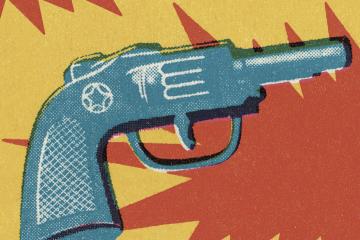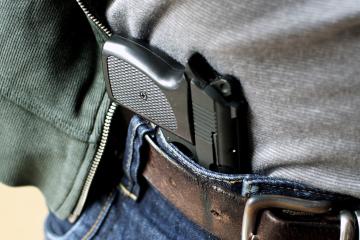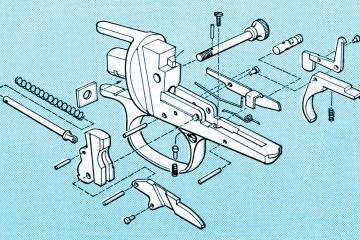When it comes to gun control measures, temporarily restricting access to firearms for people at a high risk for committing violence is one way to reduce harm. In many states, however, there are only limited legal options for doing so, even in situations where a person is making explicit threats of violence, either to themselves or others.
"The familiar refrain that we hear is, 'What are we going to do? There's no crime that's been committed," said Shannon Frattaroli, a professor of health policy whose research focuses on gun violence prevention. She is a core faculty member of the Johns Hopkins Center for Gun Violence Solutions.
This was the case in the recent mass shooting in Uvalde, Texas, where the shooter made explicit threats of violence beforehand. These threats were reported to police, who had no specific legal option to temporarily restrict the shooter's access to firearms. It appears that in the Highland Park shooting on July 4, the suspect in the shooting was able to obtain firearms despite an alleged previous suicide attempt and threats of violence against his family.
One option for temporarily removing access to firearms is an extreme risk protection order, or ERPO for short, which is legal in 19 states and the District of Columbia.
"Extreme risk protection orders are a civil option for when someone is behaving dangerously and at risk of committing violence," Frattaroli said. "This is an opportunity to intervene before a crime happens."
ERPOs, which are often called "red flag" laws, are a way to get guns out of the hands of people who are thought to be in imminent danger of committing violence, whether to themselves or others. "This is a preventive tool that is very targeted to at-risk factors that we know are very important when it comes to recognizing when violence is likely to happen," Frattaroli said.
An ERPO does two things: It prohibits a person from purchasing a firearm, while also temporarily removing any that are already in their possession. The initial order is for a short period of time, usually between one to three weeks, after which a judge will either decide to lift the ERPO or extend it for a period of up to one year.
ERPOs are modeled on existing domestic violence protection orders
ERPOs are modeled on domestic violence protection orders, which temporarily restrict access to firearms in cases of domestic violence. DVPOs are legal in all 50 states, with orders restricting firearm access being associated with a 12% reduction in intimate partner homicide. The stronger the protection order, such as extending protections to dating partners or explicitly requiring the surrender of firearms, the larger the reduction in intimate partner homicide.
"We do have good evidence showing that for the most severe forms of intimate partner violence, one of the best things that you can do is intervene with a domestic violence protection order that includes prohibitions on gun purchase and possession," Frattaroli said. "Therefore, if we expand those protections to include other types of violent threats, it stands to reason that we should expect to see reductions as well."
ERPOs restrict firearm access in moments of high risk
ERPOs are issued when a person is displaying behaviors that are known to be associated with a high risk of violence. These risk factors often include written or verbal communications about the intent to carry out violence or violent behavior.
When it comes to mass shootings, "in almost half of cases, there is documented communication from the person who committed these atrocities of what they said they were going to do," Frattaroli said. "When people say that they are planning to commit violence, we need to take that seriously."
In other instances, such as suicide or domestic violence, there are often similar warning signs, where a person expresses either an intent or a plan for harm, either in verbal or written form. Additional risk factors include a pattern of violent or erratic behavior, such as getting into fights or excessive drinking.
How ERPOs are currently being used
Although ERPOs are relatively new and only legal in some states, enough have already been issued to gain a sense of how they may be used and for what purposes. "The evidence we have suggests they are most promising for suicide," Frattaroli said. "If people are expressing an intention to harm themselves, this is a tool that can be used to intervene."
When it comes to suicide, attempts using a firearm are uniquely lethal, with 9 out of 10 attempts resulting in a fatality. Removing firearms during a crisis in which someone is threatening suicide means that the at-risk person is much more likely to survive. Given that suicides make up 60% of firearm fatalities, ERPOs can be a significant tool for reducing gun violence.
When it comes to the potential for reducing mass shootings, approximately 10% of the ERPOs Frattaroli has reviewed are for people who have expressed a desire to commit mass shootings. "All of these were credible threats, both from the person who petitioned, as well as the judge who issued the order," Frattaroli said. "I believe at least some of them would have carried through with their threats, if there had been no intervention."
Effective enforcement of ERPOs takes resources
An effective ERPO will prohibit a person from buying a new gun, while temporarily removing existing guns from their possession. Doing this effectively is a nuanced process, one that takes time, skill and resources.
When it comes to prohibiting the purchase of guns, this is an administrative function, with the protection order being entered into statewide systems so that if the respondent to an ERPO tries to buy a firearm, it comes up during a background check.
Dispossession is a more nuanced process, as it requires physically removing any existing firearms from a person's home. Ideally, when law enforcement serves the order, they will have been trained on how to handle the situation.
"This is a potentially volatile situation," Frattaroli said. "It's important to have people who are trained and skilled in handling these situations, who can do the dispossession in a way that is safe for everyone involved."
Although the recent gun safety bill that was signed into law by President Joe Biden did not extend ERPOs to the remaining states that lack them, it did allocate resources to ensuring that temporary firearm removals can be carried out safely and effectively. Frattaroli is hopeful that the funding will also go to support evaluations of how ERPOs are implemented—a critical component of ensuring gun violence policies are evidence-based.
"The funding for implementation of ERPO laws is critical," Frattaroli said. "This will hopefully provide support for the training and education needed for those who hear, serve, and enforce ERPOs."
We can all help prevent suicide. The National Suicide Prevention Lifeline provides 24/7, free, and confidential support for people in distress, prevention and crisis resources for you or your loved ones, and best practices for professionals. If you or someone you know needs help, call 1-800-273-TALK (1-800-273-8255).
Posted in Health, Voices+Opinion, Politics+Society











